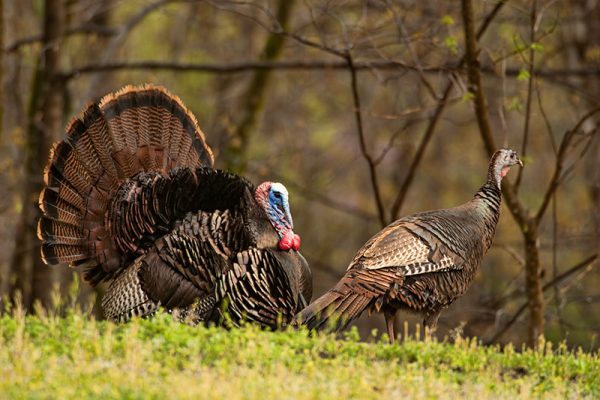Spring Turkeys’ Thunder

The woods wake up slow but loud on opening morning. First, it’s the hoot owls calling back and forth in the dark, their haunting sounds echoing through the timber. Then, the first streaks of pink and orange stretch across the horizon as the song birds begin to wake up as the landscape takes on more color. The crisp morning air smells like damp earth and fresh spring growth.
Then through the silence we hear what we’ve been waiting for.
GOBBBBLLLEEEEEE!
The first shockwave of turkey thunder rolls through the trees. Then another. And another. The timber across the ridge from me and my dad comes alive with gobblers hammering from their roosts, letting every hen in earshot know exactly where they are. My heart pounds a little harder, knowing it’s only a matter of time before they pitch down into the field in front of me.
My hunting partner, my dad, hits the slate call with a soft tree yelp, just enough to let them know we’re here. A gobbler instantly cuts him off, and we know he is keyed up and wanting to come in to the decoys. Then, wings flap. A heavy-bodied bird drops from the roost, gliding down into the pasture a couple hundred yards away. I can’t see him yet, but I know he’s there—I can hear him drumming, feel the low, thrumming vibration as he struts just out of sight. He’s getting closer.
Minutes drag on, but I sit frozen, my body turned 45 degrees from where we set up under a giant oak tree. I’m ready with my barrel pointed down, but in the direction of the tom. Then, movement. At first, it’s just the tip of a fan cresting the hill, about 50 yards out. The morning sun hits it just right, illuminating the iridescent bronze and copper hues of his feathers, and the bronze, greens, and purples that only a hunter gets to see on a live Eastern turkey. Step by step, more of him comes into view—his puffed-out chest, glowing red head. He’s no jake, he’s a full-grown tom.
He’s locked in now, his attention glued to my hen and jake decoys. His posture changes slightly, his body language shifting from dominance to pure aggression. He lets out another gobble, then another. The sound vibrates in my chest.
At thirty-five yards, I steady my gun and my finger slides to the safety. He’s now approaching 30 yards, and his head goes up. This is it. The moment every turkey hunter dreams of. With the squeeze of my finger on the trigger, the gun kicks into my shoulder and the bird flops. This is a hunt most hunters dream of, and I got to share it with my dad!
Opening Day Prep: Making Every Moment Count
Turkey season is finally here, and if there’s one thing I’ve learned over the years, it’s that success on opening day doesn’t just happen by chance. A good hunt starts well before you ever step into the woods. Being late, forgetting a crucial piece of gear, or fumbling my calls could all mean the difference between bagging a tom or going home empty-handed. I only have a handful of days to hunt, so I make them count.
The night before opening morning, I go through my gear, making sure I have my calls, choke tube screwed in my gun, plenty of ammo, the right decoys, licenses, all of my camo, especially a facemask and gloves. I run through it all, because I hate being late, and my dad hates it even more than I do. The last thing I want is to be scrambling in the dark or to realize I left something vital behind.
When the alarm finally goes off in the morning, I’m up before it has a chance to go off a second time. Legal shooting light is a half-hour before sunrise, but I like to be in my spot at least 30 minutes or earlier before that. It’s beautiful to sit and enjoy God’s creation waking up, and this is a joy only hunters get to revel in. I’ve even unknowingly set up under a roosted turkey before—one of those rare moments where my early arrival and quiet movements saved me from blowing the hunt before it even started. There’s nothing worse than bumping a bird right before the hunt.
Check the Weather
Dressing appropriately for the season is another lesson I’ve learned the hard way. Early seasons can be cold, sometimes freezing. If there’s rain in the forecast, I make sure to throw in my rain gear, or better yet a pop-up blind. Being wet and miserable makes it tough to sit still when you need to the most. Sometimes if you can wait out the rain, the toms will be ready to move and look for a hen. Know how weather affects turkey behavior. Snow and heavy rain can slow down breeding, but turkeys still need to eat. Windy days will push them into low-lying areas where they can escape the gusts.
Do Your Homework Ahead of Time
Of course, the most important factor in turkey hunting is simple: hunt where the turkeys are. It sounds obvious, but you won’t call in birds if there aren’t any in the area. Twenty years ago the amount of turkeys on my dad’s Iowa farm were a fraction that thrives there today. So, back then turkey hunting was a lot harder and our chances of shooting a tom were not as good as they are now. Preseason scouting can be key, especially if you are not familiar with the local turkey population and how they move through the land.
A telltale sign of turkey activity is scratching and droppings. As they wander through the timber, they fluff up leaf litter. By walking through a timber before season, you can likely see some turkey sign, especially around oaks. Another sign of turkey activity is droppings. Look under tall oaks, cottonwoods, and walnut trees and if they’ve been roosting there, you will see some litter on the ground. If you hunt mornings, you will begin to form a plan on where they’re roosting and where you should sit.
Gobblers don’t just wander aimlessly. They have one thing on their mind during the spring season, and that’s finding a mate. If you locate the hens, it’s only a matter of time before a tom shows up strutting his stuff. When toms are with a hen, sometimes it just takes making that hen mad or curious to walk up to your decoys with the toms following.
I always like to read about different ammo and try some different ammo. The best advice I can give you is to shoot your hunting ammo through the gun and choke you will be hunting with and pattern accordingly. Different guns like different choke tubes and different ammo. Just because something works great for your buddy doesn’t mean that it will work with your setup. So practice and shoot your gun, and know your effective range.
Setting Up for Success
Turkeys easily get hung up and won’t come in. Simple obstacles like a deep creek or woven wire fence can be enough to keep them from coming into range. I always consider the terrain when setting up because the last thing I want is a bird to hang up on the other side of a fence, gobbling like crazy but refusing to cross. I’ve learned to position myself where I have a clear line of sight and a direct path for the tom to strut right into my decoys. Also, as long as you have permission, you might have to run-and-gun and go to the birds.
Another thing you can do to increase your chances for success is to expand the hours you’re hunting. The first few hours can be great to hunt, then the toms find a hen and stick tight to her. However, once they get away from the first hens, they will be looking for another. So be ready with your call and decoys when they go looking for another hen. Some hunters claim to have success around the 11:00 time frame, while others will hunt the morning, and after lunch. Too many hunters give up after the morning roost action dies down. However, I’ve had just as much luck in the middle of the day. y. Consider hunting longer or different hours, you can stay on birds throughout the day.
At the end of the day, turkey hunting isn’t just about pulling the trigger. It’s about the preparation, the strategy, the thrill of the chase, and if you’re lucky spending time with your dad. There’s something special about putting in the work, learning the land, and matching wits with a wary old gobbler. Success is always the goal, but even if I walk away empty-handed, the experience itself is worth every early morning. So, do your homework, get your gear ready, and make the most of every hunt. With any luck, when that first gobble thunders through the woods at dawn, you’ll be in the perfect spot to make it count.
By Jessica Graham

